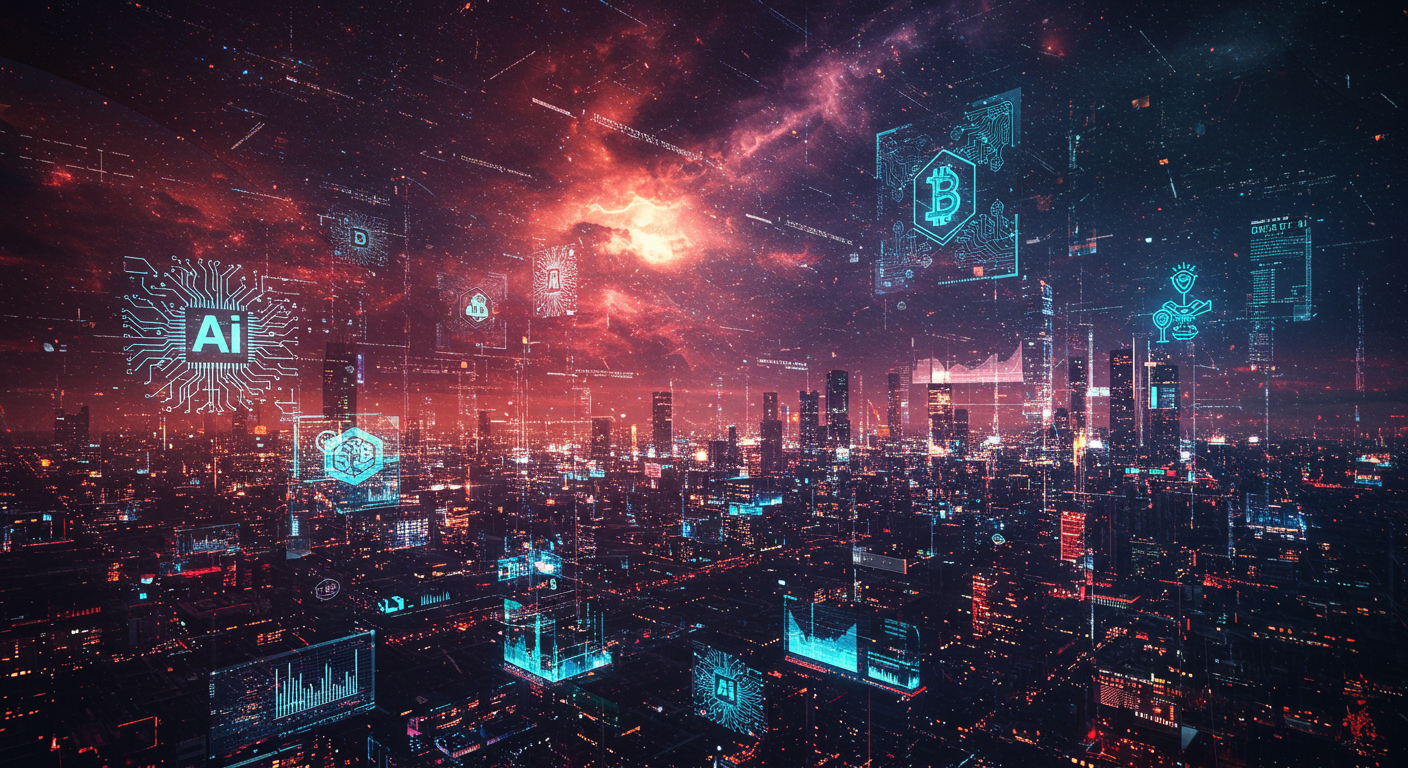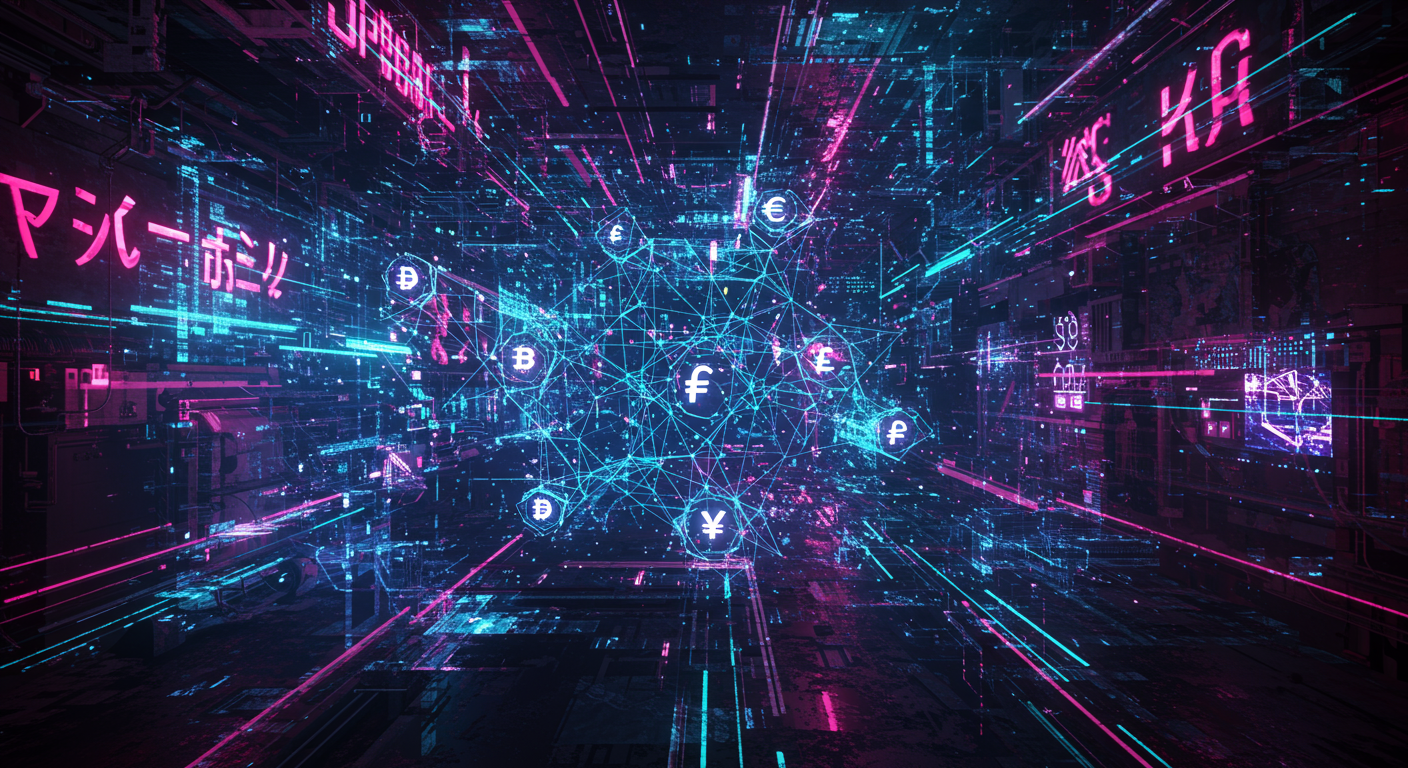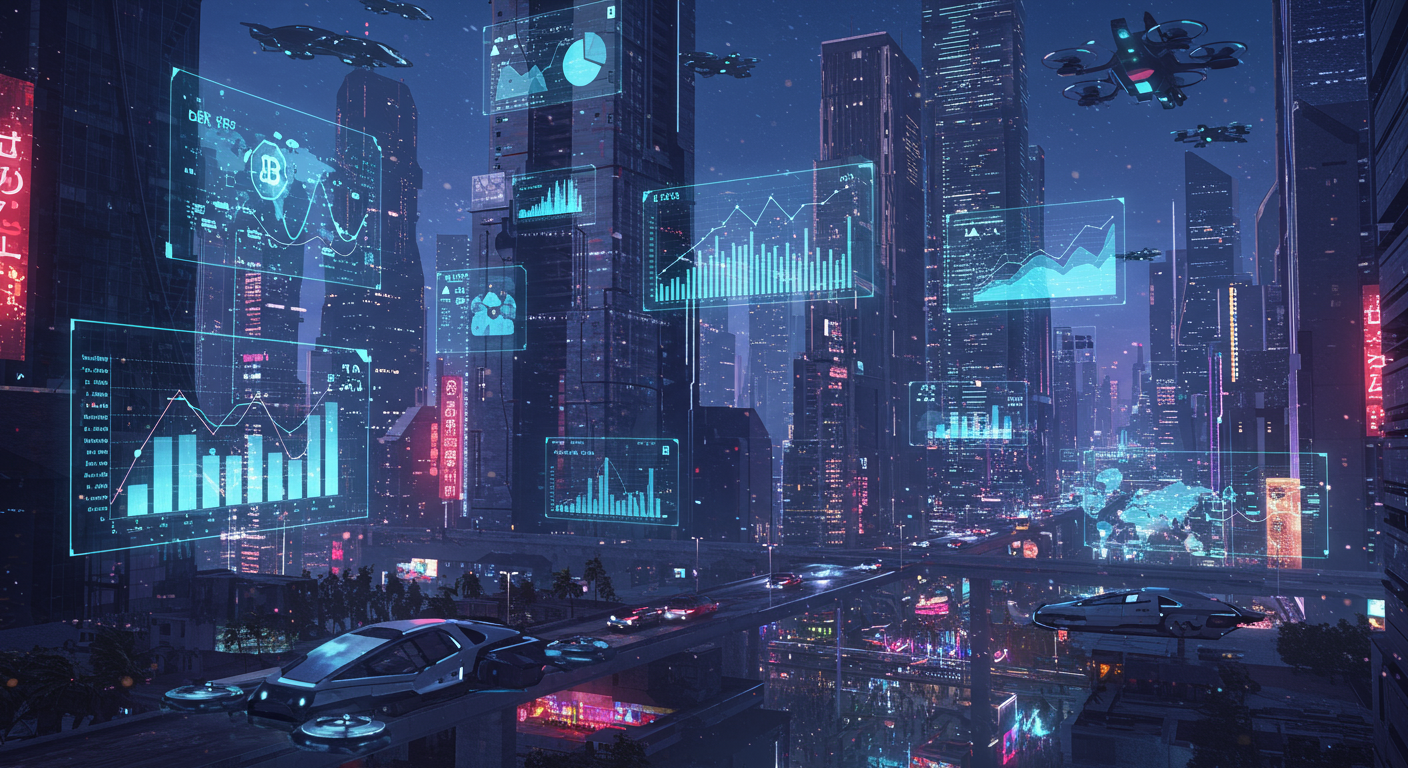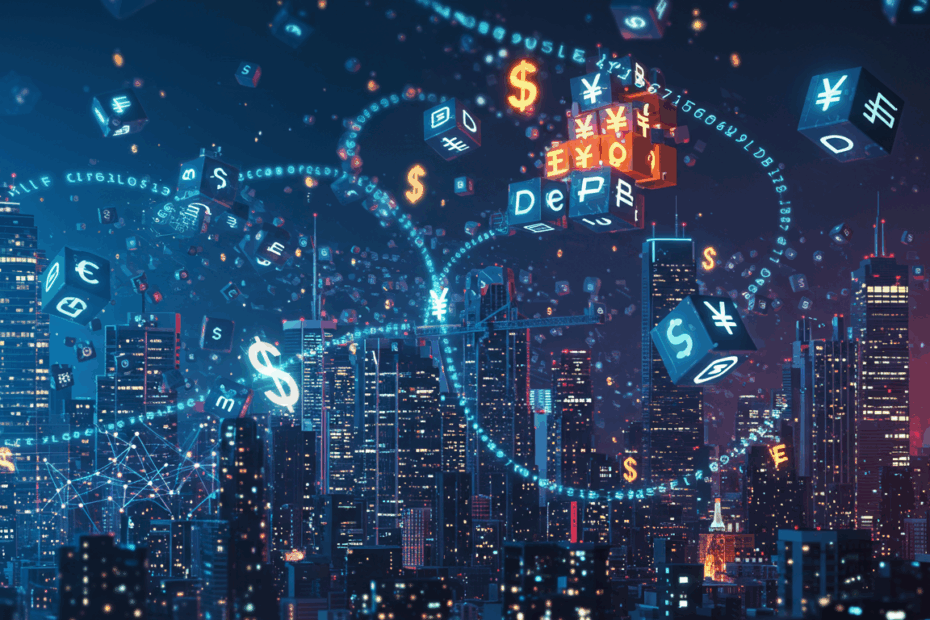The New Digital Trinity: Understanding AI, Blockchain, and DeFi
John: It’s a fascinating time to be covering technology, Lila. For years, we’ve talked about Artificial Intelligence, blockchain, and Decentralized Finance—DeFi—as separate, revolutionary forces. But what we’re witnessing in 2025 is their convergence. They’re no longer distinct pillars; they’re becoming a single, deeply integrated engine powering the next evolution of the internet, what many call the Metaverse. This isn’t just a trend; it’s the formation of a new digital-native economy.
Lila: I agree, John, the buzz is impossible to ignore. But for our readers who are new to this, the combination can sound like an alphabet soup of intimidating tech jargon. Can you break it down? How do these three powerful technologies actually fit together in a way that makes sense? What does one do that the others can’t?
John: That’s the perfect question to start with. Let’s use an analogy. Think of it like building a truly autonomous, digital city.
- Blockchain is the fundamental bedrock and infrastructure. It’s the unchangeable, transparent public record of who owns what property, the secure road network that everything travels on, and the rule of law encoded directly into the city’s foundation. It provides trust without needing a central authority like a city hall.
- DeFi (Decentralized Finance) is the entire financial system built on that infrastructure. It’s the banks, the stock exchanges, the lending services—all operating automatically on those blockchain roads, governed by smart contracts instead of bankers and brokers.
- Artificial Intelligence (AI) is the intelligence, the cognitive layer, the very ‘brain’ that makes the city smart and alive. The AI analyzes traffic on the roads, optimizes financial flows in the markets, manages the power grid, and provides personalized services to its citizens.
- Intelligent Lending and Borrowing: Established DeFi platforms are integrating AI to move beyond static interest rates. Imagine a protocol that analyzes your wallet’s transaction history, the overall market sentiment, and network congestion to offer you a personalized, dynamic interest rate for a loan, updated in real-time. This is what AI enables.
- AI-Enhanced Oracles: Oracles, like the well-known Chainlink, are vital bridges that feed real-world data onto the blockchain. AI is supercharging them. AI agents can cross-reference data from hundreds of sources, identify and discard anomalous or manipulated data, and deliver a more trustworthy, verified data stream to smart contracts. This is critical for insurance, derivatives, and prediction markets.
- AI-Powered Trading and Analytics: This is perhaps the most active area. Platforms like DexCheck are using “AI-powered information aggregation” to give traders insights that would be impossible for a human to gather manually. These tools analyze social media sentiment, developer activity on GitHub, and complex on-chain data patterns to predict market movements.
- Decentralized Science (DeSci): AI models can be trained on blockchain-verified research data to find new patterns in fields like genomics or drug discovery, with the results and intellectual property managed transparently on-chain.
- The Centralized Camp (Google, OpenAI, Amazon): They have immense advantages: vast datasets, enormous computational resources, top-tier research talent, and billions of users. Their AI products are often more polished and easier to use. However, their models are opaque “black boxes.” You don’t know why they make the decisions they do. They control the data, they can censor content or users, and their primary goal is to serve their shareholders.
- The Decentralized Camp (Projects like Bittensor, Fetch.ai, etc.): Their advantage is their architecture. They promote “AI-token projects that seek to promote transparency, traceability, and accessibility.” By building on a public blockchain, their operations are open to scrutiny. They empower users by giving them ownership of their data and a say in governance. However, they face significant headwinds like scalability, user experience friction, and coordinating development in a distributed environment.
- Smart Contract Vulnerabilities: This is the number one risk. Even with AI-powered auditing, bugs happen. As one of the SERP results from EthCC highlighted, AI tools can *introduce* subtle bugs just as easily as they can find them. A single flaw in the code of a DeFi protocol or an AI agent can be exploited for millions of dollars in an instant.
- Inherent Algorithmic Bias: An AI is only as good as the data it’s trained on. If that data reflects human biases, the AI will perpetuate and even amplify them. In a DeFi context, this could lead to an AI unfairly deeming certain users or communities as “high risk,” creating a new form of automated redlining. Blockchain’s transparency can help expose this, but it doesn’t solve the root problem.
- Economic and Oracle Manipulation: The very complexity that makes these systems powerful also creates new attack vectors. Malicious actors could use AI to execute sophisticated economic attacks, like manipulating the price of an asset on one exchange to trigger a cascade of liquidations across the entire DeFi ecosystem. They could also try to “poison” the data being fed to oracles to trick smart contracts.
- Regulatory Quicksand: Global regulators are moving slowly and uncertainly. Rules for crypto, DeFi, and AI are all in flux. A sudden crackdown or a change in legal classification could dramatically impact the value and viability of these projects overnight.
- AnChain.AI – AI-Powered Blockchain Security and Compliance
- DexCheck AI – AI-Powered Crypto and NFT Analytics
- Chainlink – The Industry Standard for Secure Oracles
- INATBA Reports – In-depth analysis on AI & Blockchain convergence
- Coinbase – Paper on Crypto and Agentic AI
So, blockchain provides the trust and security, DeFi provides the financial tools, and AI provides the optimization and intelligence to make it all work at a massive scale. Together, they create a system that can be more transparent, efficient, and user-centric than anything we’ve had before.
Lila: That city analogy really helps clarify things. The AI isn’t just a feature; it’s the active, thinking part of the system. So, when we see projects talking about the “intersection of AI and DeFi,” they’re essentially talking about building these intelligent financial services within this new digital city?
John: Precisely. They are creating the AI-powered banks and markets of tomorrow’s internet. It’s a profound shift from the passive, human-driven financial applications we’re used to.

The Core Components: AI Tokens and Decentralized Data
John: To understand how this works, we need to talk about its core components. The first and most obvious one is the rise of a new asset class: AI cryptocurrencies or AI tokens. It’s crucial to understand these are more than just speculative coins. They are the functional utility tokens that fuel this entire ecosystem.
Lila: Okay, so they’re not just like Bitcoin or Ethereum? When you say “utility,” what do you mean? What do these tokens actually *do*?
John: They serve several key functions. In many projects, they act as a payment method to access the AI’s services. For instance, you might pay in a project’s native token to use a sophisticated AI model for data analysis. They also often function as governance tokens, giving holders the right to vote on the future direction of the AI project. But most importantly, they create a micro-economy. Consider a project like Bittensor (TAO). In its network, individuals contribute their computing power to run AI models and are rewarded with TAO tokens. The tokens incentivize people to build and maintain the decentralized AI network. They are the fuel, the currency, and the ownership stake, all rolled into one.
Lila: So the tokens are the ‘supply’ of economic incentive. But what about the supply of what AI actually needs to function – data and processing power? That’s all controlled by a few Big Tech companies right now. Isn’t that a huge hurdle for a *decentralized* AI?
John: You’ve hit on the philosophical core of this movement. That’s exactly the problem “Decentralized AI” aims to solve. The current model, where companies like Google, Meta, and Amazon hoard vast amounts of user data to train their private AIs, is what this new paradigm seeks to disrupt. The Web3 approach is to create decentralized data marketplaces. Here, users can voluntarily and securely provide their data to train AI models. The blockchain provides a transparent record—or provenance—of where the data came from and how it’s used. In return, users are compensated directly with tokens. This model aims to fix the control, bias, and censorship issues inherent in Big Tech’s centralized model by giving ownership and control back to the user.
The Technical Mechanism: AI Agents and Smart Contracts
John: Now let’s get into the “how.” The real magic happens with two key pieces of technology working in tandem: Smart Contracts and a new concept called AI Agents. We’ve talked about smart contracts before—they are programs stored on a blockchain that automatically execute when preset conditions are met. They are the rigid, unchangeable rules of our digital city.
Lila: Right, the “if this, then that” logic that runs DeFi. If I deposit collateral, the smart contract gives me a loan. If the collateral’s value drops, it automatically liquidates it. It’s all code.
John: Exactly. But historically, those “if” conditions have been relatively simple. The real evolution is the introduction of AI Agents. Think of an AI Agent as an autonomous AI program that has its own crypto wallet and the ability to interact with smart contracts on its own. These agents are the “brains” we talked about earlier, now given hands to operate within the DeFi ecosystem. For example, an “AI-driven DeFi automation” agent could constantly scan thousands of DeFi platforms in real-time to find the most profitable place to stake your funds. It would analyze Annual Percentage Yields (APYs), token volatility, and potential risks like impermanent loss, then automatically move your funds to the optimal position—all without you lifting a finger.
Lila: That’s both incredible and a little terrifying. How can you trust a piece of software to make those decisions with your money? What prevents a buggy AI agent from losing everything in a split second, or a malicious actor from deploying a rogue AI to exploit the system?
John: An essential and very valid concern. This is where the synergy becomes a feedback loop. Firstly, the smart contracts the agents interact with are publicly auditable on the blockchain, providing a layer of transparency. But more importantly, AI is also being used to *secure* the ecosystem. We’re seeing a boom in AI-powered security firms, like AnChain.AI, that use machine learning to scan smart contract code for vulnerabilities *before* it’s deployed. Other tools, like the one mentioned by De.Fi, use AI to analyze a token’s smart contract on the fly to flag risks for users. Furthermore, a field called formal verification (a mathematical method to prove a program’s correctness) is being used to validate the output of AI tools that generate or optimize smart contracts. So, we’re using AI to build, optimize, and secure the very systems that other AIs will operate in. It’s a complex, self-reinforcing cycle.

The People Power: Teams and Decentralized Communities (DAOs)
John: Another major difference from traditional tech is the structure of the “team” behind these projects. While they are often started by a core group of brilliant AI scientists and blockchain engineers, the ultimate goal for many is to transition governance to their community through a DAO (Decentralized Autonomous Organization).
Lila: DAOs are fascinating. The idea that a global, distributed group of token holders can collectively act as the CEO, board of directors, and shareholders of a project is a radical departure from the corporate structure we all know. But does it actually work? Isn’t it slow and chaotic to have thousands of people voting on every decision?
John: It certainly can be, and it’s an evolving model. Early DAOs were often messy. But the tooling has improved dramatically. We now have sophisticated governance forums for debate, weighted voting systems based on token holdings or reputation, and treasury management tools to fund development proposals. The core principle is to align the incentives of everyone involved. The users, developers, and investors all have a voice and a stake in the project’s success through the tokens they hold. This community-first approach is fundamental to the Web3 ethos. It directly addresses the “Big Tech control” problem by distributing power, making the platform resistant to the whims of a single corporate entity or executive.
Lila: So, when you’re evaluating one of these AI crypto projects, looking at the health and engagement of its DAO and community is just as important as looking at its technology?
John: Absolutely. A strong, active community is often a leading indicator of a project’s long-term viability. It shows that people are not just speculating on the token price but are actively participating in building and guiding the “intelligent, self-optimizing financial layer” of the future.
Real-World Applications and the Future Outlook
John: Let’s move from the abstract to the concrete. The use cases are already emerging and they’re quite powerful. We’re not just talking about theory anymore.
Lila: It really does sound like an “intelligent financial layer” is being built brick by brick. The trading and analytics part seems like the most obvious evolution, but the lending and oracle examples show how deep this can go. Looking further out, what’s the grand vision? What does this all look like in five or ten years?
John: The grand vision is what some are calling the **Agentic Economy**. It’s a future where autonomous AI agents are primary economic actors. Imagine you own an AI agent. You give it a budget and a mandate: “Grow my digital asset portfolio while minimizing risk.” This agent, using your crypto wallet, could then go out and provide liquidity to DeFi pools, trade NFTs based on art-generating AI trend analysis, pay for its own server costs using crypto, and even use other AI services to upgrade its own strategies. Coinbase’s paper on “Crypto and Agentic AI” lays this out well. We’re talking about a world with millions of autonomous, economically-active AIs transacting with each other on the blockchain, creating a new, machine-native economy. It’s a long way off, but the foundations are being laid right now.
The Great Debate: Centralized vs. Decentralized AI
Lila: So, who are the main players or “competitors” in this space? Is it just a race between different AI crypto projects?
John: The competition is broader than that. It’s really a fundamental battle of two different philosophies: the centralized world of Big Tech versus the decentralized world of Web3.
So, when you see a project like DexCheck AI offering crypto analytics, its real competitor isn’t just another crypto tool; it’s the entire data analytics industry that operates on a centralized model. The competition is ideological.
Lila: It’s a classic trade-off then: the walled garden’s convenience versus the open frontier’s freedom. It seems the winner will be whoever can offer the benefits of decentralization without the current user-unfriendliness.
John: Exactly. The holy grail is to build a decentralized system that is just as easy and powerful to use as its centralized counterpart. The projects that crack that nut will define the future.
A Word of Warning: Risks and Cautions
John: Now, we have to inject a heavy dose of realism, Lila. This space is incredibly exciting, but it’s also fraught with risk. It is the absolute bleeding edge of technology, and that edge is sharp.
Lila: That’s a point we can’t stress enough. What are the top risks people should be aware of before they even think about engaging with these platforms?
John: There are several critical ones.
Lila: It’s a minefield. The takeaway for our readers, then, is that this is not a “get rich quick” scheme. The potential for catastrophic failure is just as high as the potential for revolutionary success.
John: Precisely. Extreme caution, thorough research, and a healthy dose of skepticism are your best friends in this space. Never, ever interact with a protocol or invest in a token without understanding the fundamental risks involved.
Expert Opinions and Market Analysis
John: Despite the risks, the expert consensus is one of cautious optimism. Analysts are no longer dismissing this as a niche interest. Reports from crypto-native intelligence firms like Token Metrics consistently show that “smart capital is flowing” into AI and DeFi 2.0 projects. The narrative has shifted. Experts now widely discuss DeFi evolving into an “intelligent, self-optimizing financial layer,” as one Medium author put it, which they believe is the key to unlocking broader institutional adoption.
Lila: Are there any dissenting expert opinions? What are the strongest arguments from the skeptics?
John: The most potent skeptical argument, which we touched on earlier, revolves around the “Illusion of Decentralized AI.” Some critics argue that many projects are “AI-in-name-only” or are not truly decentralized. They might use a blockchain token for fundraising and marketing, but their core AI model and data processing still run on centralized servers like Amazon’s AWS. This creates a facade of decentralization while retaining the single points of failure and control of a traditional tech company. It’s a valid and important critique that requires users to look beyond the marketing and investigate a project’s actual architecture.
The Road Ahead: Latest News and Future Roadmap
John: The pace of development is relentless. As we stand in mid-2025, the most significant trend is the practical deployment of the first generation of AI Agents. We’re seeing projects like Veltrixa.io attempt to bundle many of these concepts—automated trading, DeFi tools, and digital payments—into a single “AI-powered financial ecosystem.” This signals a move from single-purpose tools to integrated platforms.
Lila: So what’s next on the roadmap for the sector as a whole? What are the big problems developers are focused on solving in the next 12 to 24 months?
John: There are three main pillars of focus. First is Interoperability—making it seamless for AI agents and assets to move and communicate between different blockchains. Second is Scalability—increasing the transaction speed and reducing the costs to make these systems viable for millions of users and micro-transactions. And third, and perhaps most importantly, is User Experience (UX). The goal is to abstract away the complexity. We’re seeing the first hints of this with concepts like “conversational AI assistants,” where you can manage your complex DeFi positions simply by having a conversation with an AI, like the one “Powered by Ruby” mentioned in Digital Journal. The future is one where you don’t need to understand smart contracts to use them, just like you don’t need to understand TCP/IP to browse a website.

Frequently Asked Questions (FAQ)
What exactly is an AI Token?
John: Think of an AI Token as a multi-purpose key to a decentralized AI project. It primarily serves three roles: 1) Utility: You use it to pay for the AI’s services, like running an analysis or generating content. 2) Governance: Holding the token gives you voting rights on proposals that shape the project’s future. 3) Incentive: It’s used to reward participants who contribute resources, like computing power or data, to the network.
Is investing in AI crypto safe for a beginner?
Lila: That’s a question I get a lot from my friends. John, what’s your take?
John: In a word, no. It is not “safe” in the traditional sense. This is a high-risk, high-volatility sector. For a complete beginner, it’s far more important to spend time learning first. Read whitepapers, engage with communities on Discord or Telegram, and understand the technology. If you do decide to invest, it should only be with capital you are fully prepared to lose. Start small and focus on established projects with a clear track record and transparent team.
How does blockchain help prevent AI bias?
John: Blockchain itself doesn’t magically eliminate bias. If the data fed to an AI is biased, the AI will be biased. However, blockchain helps in a crucial way: transparency and provenance. Because the blockchain is a public ledger, it can be used to create an immutable record of the data used to train an AI model. Researchers and auditors can then examine this data to check for biases. It forces accountability. It doesn’t solve the problem, but it makes it much harder to hide.
Will this new technology make financial advisors obsolete?
Lila: It sounds like these AI agents could become so powerful. Is there still a role for human experts?
John: I believe so. These are incredibly powerful *tools*, but they are not fiduciaries. An AI can optimize a portfolio based on the parameters it’s given, but it can’t understand your unique life circumstances, your long-term goals, or your emotional tolerance for risk. I see a future where human advisors use these AI tools to provide better, data-driven advice to their clients. The human element of trust, understanding, and holistic planning remains irreplaceable.
Related Links and Further Reading
Disclaimer: The content in this article is for informational purposes only. It should not be construed as financial, legal, or investment advice. The cryptocurrency and DeFi markets are highly volatile and risky. Please do your own research (DYOR) and consult with a professional advisor before making any financial decisions.
